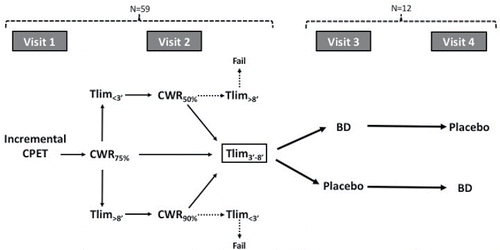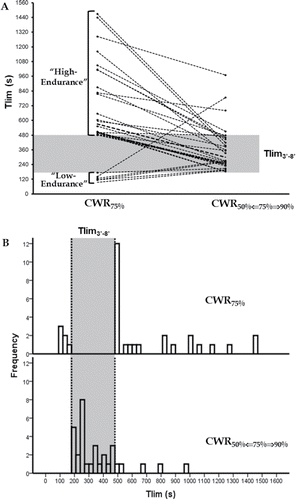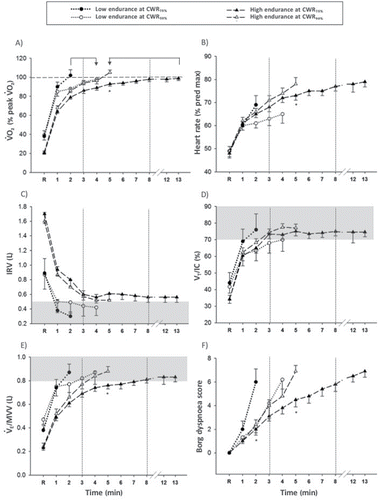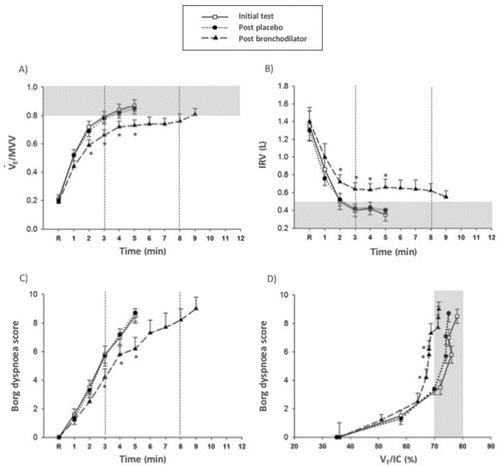Figures & data
Figure 1. Study protocol. CPET: cardiopulmonary exercise test; CWR: constant work rate; Tlim: time to exercise intolerance; BD: bronchodilator.

Table 1. Resting and exercise characteristics of the whole sample and subgroups based on tolerance to the initial endurance test (CWR75%).
Figure 2. Individual time to limitation (Tlim) in response to constant work rate testing at 75% peak (CWR75%) and after intensity adjustment (CWR50%⇐75%⇒90%) in patients whom CWR75% did not provide Tlim between 3 and 8 min (Tlim3′–8′) (N = 32, panel A). Tlim distribution in response to CWR75% and CWR50%⇐75%⇒90% is shown in panel B. Note that a fraction of “high-endurance” patients were told to stop exercising at the 8th minute during CWR75% (N = 8): this explains higher Tlim frequency near this time point. Tlim: time to intolerance; Tlim3′–8′: time to intolerance within 3 to 8 minutes; CWR: constant work rate.

Table 2. Physiological and sensory responses to constant work rate (CWR) test at different percentage of peak WR in COPD patients separated by tolerance to the initial endurance test (CWR75%).
Figure 3. Metabolic, cardiovascular, mechanical-ventilatory and sensory responses in patients whom initial CWR75% was shorter than 3 min (“low-endurance”) or longer than 8 min (“high-endurance”) and the effect of repeating the test at lower (CWR50%) or higher (CWR90%) intensities, respectively. ̇VO2: oxygen consumption; HR: heart rate; IRV: inspiratory reserve volume; VT: tidal volume; IC: inspiratory capacity; ̇VE: ventilation; MVV: maximum voluntary ventilation. *p < 0.05 for CWR90% vs. CWR75% at isotime. ǂp < 0.05 for CWR50% vs. CWR75% at isotime.

Figure 4. Metabolic, cardiovascular, mechanical-ventilatory, and sensory responses patients whom initial CWR75% was within the desired time range (Tlim3′–8′) and those who reached Tlim3′–8′ after repeating the test at CWR50% (“low-endurance”) or CWR90%(“high-endurance”).̇VO2: oxygen consumption; HR: heart rate; IRV: inspiratory reserve volume; VT: tidal volume; IC: inspiratory capacity; ̇VE: ventilation; MVV: maximum voluntary ventilation. *p < 0.05 for low-endurance at CWR50% vs. mid-endurance at CWR75% and high-endurance at CWR90%.

Figure 5. Mechanical-ventilatory and sensory responses in the subgroup of patients (N = 12) who exercised at the work rate associated with Tlim3′–8′ after placebo and bronchodilator. IRV: inspiratory reserve volume; ̇VE: ventilation; MVV: maximum voluntary ventilation; VT: tidal volume; IC: inspiratory capacity. *p < 0.05 for postbronchodilator vs. initial/postplacebo tests at isotime.

